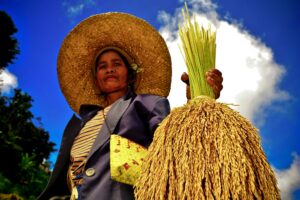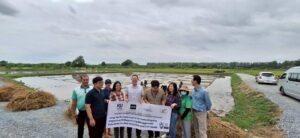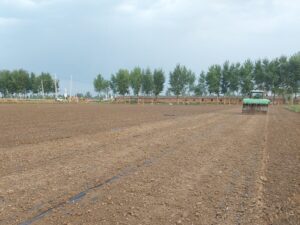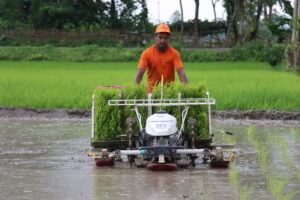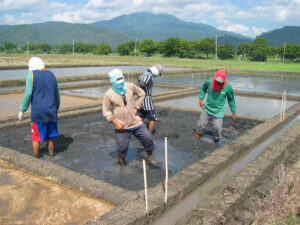Providing a relative magnitude of returns to investments is important for donors so that they can see whether payoffs still exist to fund this type of varietal improvement research. Return estimates can serve as justification for further research investments in the future as well as help guide future allocations. The findings from this study suggest that net returns to IRRI rice varietal development efforts are still strongly positive in the Philippines and Bangladesh. The yield benefits of using rice varieties with IRRI parentage in the two countries more than compensate for IRRI and its national agricultural research and extension system partners’ investments to develop and disseminate IRRI-related varieties.
Research and development (R&D) investments in agriculture have long been used by rice-growing nations in Asia to boost or maintain production, help overcome domestic food insecurity, and meet economic development goals. For the past half-century, national and international research organizations such as the CGIAR have mobilized and invested large amounts of resources oriented to advancing further rice R&D and strengthening national research partners.
For example, there is a long history of collaborative research between the International Rice Research Institute (IRRI, a founding member of the CGIAR), and national agricultural research and extension system (NARES) partners to address rice production challenges throughout R&D that can produce improved rice varieties, develop efficient agronomic practices and technologies, and increase the scientific capacity of local researchers.
Although agricultural R&D investment is increasing over time, public spending on agricultural R&D is lower in developing countries than in developed countries, and the main countries investing have shuffled over time, with a substantial growth for middle-income countries.
In the Philippines and Bangladesh, for instance, only 0.4% of their agricultural gross domestic product was invested in agricultural research in 2017 and 2016, respectively.
A relatively large investment in rice R&D compared to other crops and the subsequent adoption of improved varieties1 produced by these investments have arguably benefited rice production growth in several developing countries in Asia, such as the Philippines and Bangladesh.
Improved varieties in the Green Revolution era of the 1960s through the 1980s have arguably been the main research innovation that has driven rice production growth in Asia. By the late 1990s, improved inbred and hybrid varieties of rice had replaced the most commonly adopted varieties on more than 100 million harvested hectares annually in Asia.
The annual gains from the improved varieties of rice adopted in South and Southeast Asia were USD 10.8 billion (nominal) per year in the late 1990s. As such, R&D investments from IRRI and its NARES partners are often mentioned as one of the factors that have contributed to the robust rice production growth in Asia through the 1990s.
However, questions have been raised about whether rice varietal improvements continue to be a relevant factor that influences rice productivity growth in the major rice-producing nations in Asia, especially in more recent years. For example, several articles have indicated that the pace of varietal replacement in many parts of Asia has slowed down and there have been smaller increases in yield potential since the 1990s.
Some have even implied that rice yield growth has started to fall below rice consumption growth such that future food security might be compromised if this trend continues. Therefore, it is an appropriate time to assess whether recent rice research investments by IRRI and its NARES partners in varietal development programs still generate commensurate positive net economic returns in terms of rice production growth in the major rice-producing countries in Asia.
Providing a relative magnitude of returns to investments is important for donors so that they can see whether payoffs still exist to funding this type of varietal improvement research. These return estimates can serve as justification for further research investments in the future as well as help guide future allocations (i.e., which countries and what type of varietal efforts to support and fund).
The findings from this study suggest that net returns to IRRI rice varietal development efforts are still strongly positive in the Philippines and Bangladesh. The yield benefits of using rice varieties with IRRI parentage in the two countries more than compensate for IRRI and its NARES partners’ investments to develop and disseminate IRRI-related varieties.
The results suggest that returns to IRRI investments in the Philippines and Bangladesh have slowed down relative to returns observed prior to the 1990s. The findings suggest that the use of IRRI genetic materials is likely to be decreasing in the Philippines. Hence, the net welfare contributions of IRRI-related varieties in the Philippines tend to be lower than in Bangladesh.
Our results show that the Philippines and Bangladesh have made huge investments in the development of improved rice varieties over the past three decades and the economic returns to these investments in rice research were significant. A technology-led rice productivity growth through investment in R&D would generate substantial returns, which could contribute to improving the livelihoods of millions of rice farmers and consumers in these two major rice economies of Asia.
Although the national research capacity to develop new rice varieties has improved over time, public agricultural research spending is still low, along with insufficient research capacity to use modern rice breeding methods and tools. Also, the national systems lack access to a large pool of germplasm and the capacity to analyze and use that germplasm.
To address these constraints, the NARES partners need support from advanced research institutes such as IRRI and other CGIAR members. Therefore, IRRI/CGIAR should continue working on rice R&D in these two countries with priority to support the NARES in capacity development, use of modern breeding methods and tools, application of advanced research, and access to rice germplasm.
The results showed that the returns to IRRI and its NARES partners’ investment in rice R&D and extension in these two countries are substantial, but have been declining. Therefore, IRRI management and donors should allocate adequate resources to continue IRRI and its NARES partners’ rice R&D and extension programs in the Philippines and Bangladesh.
The objective of this study is to evaluate the net economic contributions of IRRI’s rice varietal improvement efforts with regard to rice production growth in two major rice economies of Asia, namely, the Philippines and Bangladesh. Specifically, we examine whether the value of rice production growth due to IRRI and its NARES partners’ varietal development programs outweighs the investments made in these programs for the Asian countries.
Data from a variety of sources were used to operationalize the economic surplus approach and determine the net economic returns to rice research and extension investments in IRRI’s varietal improvement programs.
Read the study:
Dikitanan R, Pede V, Rejesus R, Bhandari H, Alam GMM, Andrade R (2022) Assessing returns to research investments in rice varietal development: Evidence from the Philippines and Bangladesh. Global Food Security, Volume 33

